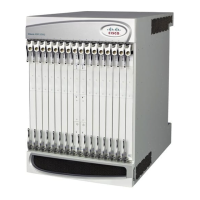Enhanced Charging Service Overview
▄ Cisco ASR 5000 Series Product Overview
When a change of PDP context conditions (QoS change, SGSN change, PLMN Id change, RAT change)
occurs a set of List of Service Data (LOSDV) and List of Traffic Volume (LOTV) containers, i.e. all active
service data flow containers, will be added to eG-CDR.A maximum of 10 LOSDV containers are supported
per eG-CDR.A maximum of 8 LOTV containers are supported per eG-CDR.
When a change of tariff time occurs a set of List of Service Data (LOSDV) and List of Traffic Volume
(LOTV) containers, i.e. all active service data flow containers, will be added to eG-CDR.A maximum of 10
LOSDV containers are supported per eG-CDR.A maximum of 8 LOTV containers are supported per eG-
CDR.
Failure handling
procedure
triggering
When the failure handling mechanism is triggered and the failure action is set to ―continue‖ a set of List of
Service Data (LOSDV) and List of Traffic Volume (LOTV) containers, i.e. all active service data flow
containers, will be added to eG-CDR.A maximum of 10 LOSDV containers are supported per eG-CDR.A
maximum of 8 LOTV containers are supported per eG-CDR.
When an expiry of time limit, volume limit or termination is detected for a service data flow a set of List of
Service Data (LOSDV) container is added to eG-CDR.A maximum of 10 LOSDV containers are supported
per eG-CDR.
When a CDR closure occurs all active List of Service Data (LOSDV) container is added to eG-CDR.A
maximum of 10 LOSDV containers are supported per eG-CDR.
Triggers to Close eG-CDRs
The following table lists the trigger conditions to close the eG-CDR.
Table 92. Triggers for closing an eG-CDR
End of PDP context in GGSN
De-activation of the PDP context in the GGSN closes the eG-CDR. The trigger condition covers:
Termination of PDP context
Any abnormal release of PDP context
eG-cDRs can be closed due to operation parameters and conditions.This trigger reason covers:
Data volume limit
Time duration limit
Maximum number of charging condition changes (QoS/tariff time change)
Management intervention
MS/Subscriber time zone change
Inter PLMN SGSN change
Radio Access Technology (RAT) change

